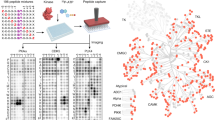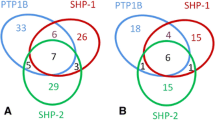Abstract
Synthetic peptides such as P60stc autophosphorylation site peptides and angiotensin are indiscriminately phosphorylated by protein tyrosine kinases. The observation has led to the general belief that protein tyrosine kinases are highly promiscuous, displaying littlein vitro site specificity. In recent years, evidence has been accumulating to indicate that such a belief requires close examination. Synthetic peptides showing high substrate activity for specific groups of protein tyrosine kinases have been obtained. Systematic modification of certain substrate peptides suggests that kinase substrate determinants reside with specific amino acid residues proximal to the target tyrosine. A number of protein kinases have been shown to be regulated by tyrosine phosphorylation at specific sites by highly specific protein tyrosine kinases. These and other selected biochemical studies that contribute to the evolving view ofin vitro substrate specificity of protein tyrosine kinases are reviewed.
Similar content being viewed by others
References
Fischer EH, Graves DJ, Crittenden ERS, Krebs EG: Structure of the site phosphorylated in phosphorylaseb toa reaction. J Biol Chem 234: 1698–1704, 1959
Nolan C, Novoa WB, Krebs EC, Fischer EH: Further studies on the site phosphorylated in the phosphorylaseb toa reaction. Biochemistry 3: 542–551, 1964
Kemp BE, Bylund DB, Huang T, Krebs EG: Substrate specificity of the cyclic AMP-dependent protein kinase. Proc Natl Acad Sci USA 72: 3448–3452, 1975
Graves DJ: Use of peptide substrate to study the specificity of phosphorylase kinase phosphorylation. Method Enzymol 99: 268–278, 1983
Kemp BE, Pearson RB: Protein kinase recognition sequence motifs. Trends Biochem Sci 15: 342–346, 1990
Kennelly PJ, Krebs EG: Consensus sequences as substrate specificity determinants for protein kinases and protein phosphatases. J Biol Chem 266: 15555–15558, 1991
Pearson RB, Kemp BE: Protein kinase phosphorylation site sequences and consensus specificity motifs: tabulations. Method Enzymol 200: 62–81, 1991
Hunter T: Synthetic peptide substrates for tyrosine kinase. J Biol Chem 257: 4843–4848, 1982
House C, Baldwin GS, Kemp BE: Synthetic peptide substrates for the membrane tyrosine protein kinase stimulated by epidermal growth factor. Eur J Biochem 140: 363–369, 1984
Pike LJ, Gallis B, Casnellie JE, Bornstein P, Krebs EG: Epidermal growth factor stimulates the phosphorylation of synthetic tyrosine-containing peptides by A431 cell membranes. Proc Natl Acad Sci USA 79: 1443–1447, 1982
Baldwin GS, Stanley IJ, Nice EC: A synthetic peptide containing the autophosphorylation site of the transforming proteins of Harvey sarcoma virus is phosphorylated by EGF-stimulated tyrosine kinase. FEBS Lett 153: 257–260, 1983
Casnellie JE, Krebs EG: The use of synthetic peptides for defining the specificity of tyrosine protein kinases. Adv Enzyme Regul 22: 501–515, 1984
Wong TW, Goldberg AR:In vitro phosphorylation of angiotensin analogs by tyrosyl protein kinases. J Biol Chem 258: 1022–1025, 1983
Braun S, Raymond WE, Racker E: Synthetic tyrosine polymer as substrates and inhibitors of tyrosine specific protein kinases. J Biol Chem 259: 2051–2054, 1984
Hunter T, Cooper JA: Protein tyrosine kinases. Ann Rev Biochem 54: 897–930, 1985
Kasuga M, Fujita-Yamaguchi Y, Blithe DL, White MF, Kahn CR: Characterization of the insulin receptor kinase purified from human placental membranes. J Biol Chem 258: 10973–10979, 1983
Marin O, Donella-Deana A, Brunati AM, Fischer S, Pinna LA: Peptides reproducing the phosphoreceptor sites of PP60c-src as substrates for TPK-IIB, a splenic tyrosine kinase devoid of autophosphorylation activity. J Biol Chem 266: 17798–17803, 1991
Geahlen RL, Harrison ML: Protein tyrosine kinases, In: BE Kemp (ed.) Peptides and Proteins Phosphorylation. Uniscience CRC Press, Boca Raton, Florida, 1990, pp 239–253
Akiyama T, Kadowaki T, Nishida E, Kedooka T, Egawala H, Fukani Y, Sakai H, Takaku F, Kasuga M: Substrate specificities of tyrosine-specific protein kinases toward cytoskeletal proteinsin vitro. J Biol Chem 262: 14797–14803, 1986
Kadowaki T, Koyasu S, Nishida E, Tobe K, Iqumi T, Takaku F, Sakai H, Yahara I, Kasuga M: Tyrosine phosphorylation of common and specific sets of cellular protein rapidly induced by insulin, insulin-like growth factor 1 and epidermal growth factor in intact cell. J Biol Chem 262: 7342–7350, 1987
Cheng N, Sahyoun M: Neuronal tyrosine phosphorylation in growth cone glycoproteins. J Biol Chem 263: 3935–3942, 1988
Wang CY, Kong SK, Wang JH: Characterization of fodrin phosphorylation by a spleen protein tyrosine kinase. Biochemistry 27: 1254–1260, 1988
Matten WT, Aubry M, West J, Maness PI: Tubulin is phosphorylated at tyrosine by PP60c-src in nerve growth core membrane. J Cell Biol 111: 1959–1970, 1990
Margolis B, Rhee SG, Felder S, Mervic M, Lyall R, Levitzki A, Ullrich A, Zilberstein A, Schlessinger J: EGF induces tyrosine phosphorylation of phospholipase C-II: A potential mechanism for EGF receptor signalling. Cell 57: 1101–1107, 1989
Park DJ, Rho HW, Rhee SG: CD3 stimulation causes phosphorylation of phospholipase C-r1 on serine and tyrosine residues in human T-cell. Proc Natl Acad Sci USA 88: 5453–5456, 1991
Weiss A, Koretzki G, Schatzwan R, Kadlecek T: Functional activation of the T-cell antigen receptor induces tyrosine phosphorylation of phospholipase C-r1. Proc Natl Acad Sci USA 88: 5484–5488, 1991
Bustelo XR, Ledbetter JA, Barbacid M: Product of vav proto-oncogene defines a new class of tyrosine potein kinase substrates. Nature 356: 68–71, 1992
Margolis B, Hu P, Katzav S, Li W, Oliver JM, Ullrich A Weiss A, Schlessinger J: Tyrosine phosphorylation of vav proto-oncogene product containing SH2 domain and transcription factor motifs. Nature 356: 71–74, 1992
Edelman AM, Blumenthal DK, Krebs EG: Protein serine/threonine kinases. Ann Rev Biochem 56: 567–613, 1987
Mooibroek MJ, Cheng H-C, Wang JH: Differentialin vitro phosphorylation of clathrin light chains by epidermal growth factor receptor-associated protein tyrosine kinase and a PP60c-src-related spleen tyrosine kinase. Arch Biochem Biophys 292: 448–455, 1992
Gould KL, Nurse P: Tyrosine phosphorylation of the fission yeast cdc2 protein kinase regulates entry into mitosis. Nature 339: 626–629, 1989
Norbury C, Nurse P: Animal cell cycle. Ann Rev Biochem 61: 441–470, 1992
Featherstone C, Russell P: Fission yeast P107weel mitotic inhibitor is a tyrosine/serine kinase. Nature 349: 808–811, 1991
Igarashi M, Nagata A, Jinno S, Suto K, Okayawa H: Wee1-like gene in human cells. Nature 353: 80–83, 1991
McGowen CH, Russell P: Human Wee1 kinase inhibits cell division by phosphorylating P34cdc2 exclusively on Tyr-15. EMBO J 12: 75–85, 1993
Parker LL, Atherton-Fessler S, Piwnica-Worms H: P107weel is a dual-specificity kinase that phosphorylates P34cdc2 on tyrosine 15. Proc Natl Acad Sci USA 89: 2917–2921, 1992
Hughes K, Nikalakaki E, Plyte SE, Totty NF, Woodgett JR: Modulation of the glycogen synthase kinase-3 family by tyrosine phosphorylation. EMBO J 12: 803–808, 1993
Seger R, Ahn NG, Posoda J, Munar ES, Jensen AM, Cooper JA, Cobb MH, Krebs EG: Purification and characterization of mitogen-activated protein kinase activator(s) from epidermal growth factor-stimulated A431 cells. J Biol Chem 267: 14373–14381, 1992
Payne DM, Rossowando SJ, Martino P, Erickson AK, Her JH, Shabbuowitz J, Hunt DF, Weber MJ, Sturgill JW: Identification of the regulatory phosphorylation sites in PP42/mitogen-activated protein kinase (MAP-kinase). EMBO J 10: 885–892, 1991
Nada S, Okada S, Yamanushi Y, Yamamato T, Nakagawa H: ‘CSK’ a protein tyrosine kinase involved in regulation of src family kinases. J Biol Chem 266: 24249–2452, 1991
Bergman M, Mustelin T, Oetken C, Partanen J, Hlint NK Aurein KE, Autero M, Buru P, Alitelo K: The human P50csk tyrosine kinase phosphorylates P56lck at tyr505 and down regulates its catalytic activity. EMBO J 11: 2919–2924, 1992
Baldwin GS, Burgess AW, Kemp BE: Phosphorylation of a synthetic gastrin peptide by the tyrosine kinase of A431 cell membranes. Biochem Biophys Res Commun 109: 656–660, 1982
Rosen OM: After insulin binds. Science 237: 1452–1458, 1987
Levine BA, Clark B, Ellis L: A soluble insulin receptor kinase catalyzes ordered phosphorylation at multiple tyrosines of a decapeptide substrate. J Biol Chem 266: 3565–3570, 1991
Sun XJ, Rottenberg P, Kahn CR, Bacher JM, Araki E, Wilden PA, Cahill DA, Goldstein BJ, White MF: Structure of the insulin receptor substrate IRS-1 defines a unique signal transduction protein. Nature 352: 73–77, 1991
Shoelson SE, Chatterjee S, Chaudhuri M, White MF: YMXM motifs of IRS-1 define substrate specificity of the insulin receptor kinase. Proc Natl Acad Sci USA 89: 2027–2031, 1992
Cooper JA: The SRC family of protein tyrosine kinases. In: BE Kemp (ed.) Peptides and Protein Phosphorylation. Uniscience CRC Press, Boca Raton, Florida 1990, pp 85–113
Litwin C, Cheng H-C, Wang JH: Purification and characterization of a PP60c-src-related tyrosine kinase that efficiently phosphorylates a synthetic peptide drived from P34cdc2 J Biol Chem 266: 2557–2566, 1991
Cheng H-C, Litwin C, Hwang DM, Wang JH: Structural basis of specific and efficient phosphorylation of peptides derived from P34cdc2 by a PP60c-src-related tyrosine kinase. J Biol Chem 266: 17919–17925, 1991
Cheng H-C, Nishio H, Hatase O, Ralph S, Wang JH: A synthetic peptide derived from P34cdc2 is a specific and efficient substrate of src family tyrosine kinases. J Biol Chem 267: 9248–9256, 1992
Litwin C: Purification and characterization of P56lyn from bovine spleen. Ph.D. Thesis, University of Calgary.
Author information
Authors and Affiliations
Rights and permissions
About this article
Cite this article
Cheng, HC., Matsuura, I. & Wang, J.H. In vitro substrate specificity of protein tyrosine kinases. Mol Cell Biochem 127, 103–112 (1993). https://doi.org/10.1007/BF01076761
Issue Date:
DOI: https://doi.org/10.1007/BF01076761




